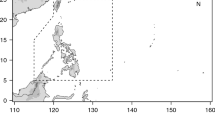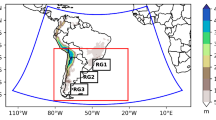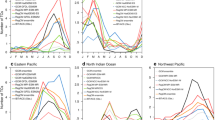Abstract
The RegCM3 (Regional Climate Model—version 3) was nested in HadAM3 model to simulate present (1975–1989, referred hereafter as RegHad) and two future climate scenarios (A2 and B2 from 2071 to 2085, referred as RegA2 and RegB2) over the South America (SA) and South Atlantic Ocean (SAO). Projected changes in the air temperature, precipitation, low level circulation and cyclogenesis climatology were investigated. The cyclogenesis were identified using an automatic scheme for tracking based on the minimum of relative vorticity (ζ) from 10-m height wind. During summer, a general decrease (increase) in the precipitation is projected by RegA2 and RegB2 over the northeastern SA (center-west and south Brazil, north Argentina and Uruguay). For winter, an anomalous low level anticyclonic circulation is associated with the reduction in the rainfall over the central part of southern Brazil in RegA2 and RegB2 scenarios. Similar to HadAM3, RegCM3 projects larger warming in A2 scenario. For the present climate, when compared to HadAM3, RegHad defines better both the location of the main cyclogenetic areas and its annual cycle near southwestern SAO. The projections indicate a reduction in the total number of cyclones of −7.2% and −4.7% for RegA2 and RegB2, respectively, while HadAM3 reduction is ~−4.5% for both scenarios. The decrease is larger for initially intense cyclones (ζ ≤ −2.5 × 10−5 s−1): −20.9% (RegA2) and −11.3% (RegB2). For the lifetime, distance traveled and mean velocity of the cyclones, the A2 and B2 scenarios present mean values close to the present climate (~3 days, ~1900 km, and ~9 m s−1, respectively). Regarding the initial mean vorticity of the systems, RegB2 simulates values similar to the present climate, but they are initially weaker in RegA2. In general, RegA2 and RegB2 show a large decrease in the number of cyclones over the southern SAO due to an anticyclonic anomaly covering SAO between 30–55°S. The reduction is larger in the scenario with higher concentrations of greenhouse gases (RegA2).










Similar content being viewed by others
References
Bengtsson L, Hodges KI, Roeckner E (2006) Storm tracks and climate change. J Clim 19:3518–3543
Cressman GP (1959) An operational objective analysis system. Mon Wea Rev 7(10):367–374
da Rocha RP, Morales CA, Cuadra SV, Ambrizzi T (2009) Precipitation diurnal cycle and summer climatology assessment over South America: An evaluation of Regional Climate model version 3 simulations. J Geophys Res 114:D10108. doi:10.1029/2008JD010212
Dickinson RE, Henderson-Sellers A, Kennedy PJ (1993) Biosphere-atmosphere transfer scheme (BATS) version 1E as coupled to the NCAR community climate model. Tech Rep TN-387+STR, NCAR, Boulder, Colorado
Fernandez JPR, Franchito SH, Rao VB (2006) Simulation of the summer circulation over South America by two regional climate models. Part I: Mean Climatology. Theor Appl Climatol 86:247–260
Fyfe JC (2003) Extratropical southern hemisphere cyclone: harbingers of climate change? J Clim 16:2802–2805
Gan MA, Rao BV (1991) Surface ciclogenesis over South America. Mon Wea Rev 119:293–302
Gan MA, Kousky VE, Roupelowski CF (2004) The South America monsoon rainfall over West-Central Brazil. J Clim 17:47–66
Giorgi F, Mearns LO (1999) Introduction to special section: regional climate modeling revisited. J Geophys Res 104(D6):6335–6352
Gordon C, Cooper C, Senior CA, Banks H, Gregory JM, Johns TC, Mitchell JFB, Wood RA (2000) The simulation of SST, sea ice extents and ocean heat transports in a version of the Hadley Centre coupled model without flux adjustments. Clim Dyn 16:147–168
Grell GA (1993) Prognostic evaluation of assumptions used by cumulus parameterizations. Mon Wea Rev 121:764–787
Holtslag AAM, de Bruijn EIF, Pan HL (1990) A high resolution air mass transformation model for short-range weather forecasting. Mon Wea Rev 118:1561–1575
Hoskins BJ, Hodges KI (2005) A new on Southern Hemisphere storm tracks. J Clim 18:4108–4129
Intergovernamental Panel on Climate Change – IPCC AR4 (2007) Climate Change 2007: The Scientific Basis, IPCC, Genebra
Johns TC, Gregory JM, Ingram WJ, Johnson CE, Jones A, Mitchell JFB, Roberts DL, Sexton DMH, Stevenson DS, Tett SFB, Woodage MJ (2001) Anthropogenic climate change for 1860 to 2100 simulated with the HadCM3 model under updated emission scenarios. Hadley Centre Technical Note No. 22
Jones C, Carvalho LMV (2002) Active and break phases in the South American Monsoon System. J Clim 15:905–914
Kalnay E, Kanamitsu M, Kistler R et al (1996) The NCEP/NCAR 40-Year Reanalysis Project. Bull Am Meteor Soc 77:437–471
Kanamitsu M, Ebisuzaki W, Woollen J, Yang SK, Hnilo JJ, Fiorino M, Potter GL (2002) NCEP-DOE AMIP-II Reanalysis (R-2). Bull Am Met Soc 83:1631–1643
Kiehl JT, et al (1996) Description of the NCAR Community Climate Model (CCM3). Tech Rep TN-420+STR, NCAR, Boulder, Colorado
Knutson TR, McBride JL, Chan J, Emanuel K, Holland G, Landsea C, Isaac H, Kossin JP, Srivastava AK, Sugi M (2010) Tropical cyclones and climate change. Nat Geosci 3:157–163. doi:10.1038/ngeo779
Kodama Y-M (1992) Large-scale common features of subtropical precipitation zones (the Baiu frontal zone, the SPCZ, and the SACZ), Part I: Characteristics of subtropical frontal zones. J Meteor Soc Japan 70:813–835
Kousky EV (1980) Diurnal rainfall variation in northeast Brazil. Mon Wea Rev 108:488–498
Lambert SJ, Fyfe JC (2006) Changes in winter cyclone frequencies and strengths simulated in enhanced greenhouse warming experiments: results from the models participating in the IPCC diagnostic exercise. Clim Dyn 26:713–728
Lionello P, Boldrin U, Giorgi F (2008) Future changes in cyclone climatology over Europe as inferred from a regional climate simulation. Clim Dyn 30:657–671
Loveland TR, Reed BC, Brown JF, Ohlen DO, Zhu J, Yang L, Merchant JW (2000) Development of a global land cover characteristics database and IGBP DISCOVER from 1-km AVHRR Data. Int J Remote Sensing 21:1303–1330
Marengo JA, Ambrizzi T, da Rocha RP, Alves LM, Cuadra SV, Valverde MC, Torres RR, Santos DC, Ferraz SET (2010) Future change of climate in South America in the late twenty-first century: intercomparison of scenarios from three regional climate models. Clim Dyn 35:1073–1097. doi:10.1007/s00382-009-0721-6
Nakicenovic N, Alcamo J, Davis G et al. (2000) Special Report on Emissions Scenarios: A Special Report of Working Group III of the Intergovernmental Panel on Climate Change, Cambridge University Press, Cambridge, U.K http://www.grida.no/climate/ipcc/emission/index.htm. Accessed 20 September 2010
Necco GV (1982a) Comportamiento de Vortices Ciclonicos En El Area Sudamerica Durante El FGGE: ciclogenesis. Meteorologica 13(1):7–19
Necco GV (1982b) Comportamiento de Vortices Ciclonicos En El Area Sudamerica Durante El FGGE: Trayectorias y Desarrollos. Meteorologica 13(1):21–34
Nuñez MN, Solman S, Cabré MF (2009) Regional climate change experiments over Southern South America. II: Climate change scenarios in the late twenty first century. Clim Dyn 32(7–8):1081–1095
Pal JS, Small EE, Eltahir EAB (2000) Simulation of regional-scale water and energy budgets: Representation of subgrid cloud and precipitation processes within RegCM. J Geophys Res 105(D24):29579–29594
Pal JS, Giorgi F, Bi X et al (2007) Regional climate modeling for the developing world: the ICTP RegCM3 and RegCNET. Bull Am Met Soc 88:1395–1409
Pezza AB, Ambrizzi T (2003) Variability of Southern Hemisphere cyclone and anticyclone behavior: further analysis. J Clim 16:1075–1083
Pope VD, Gallani ML, Rowntree PR, Stratton RA (2000) The impact of new physical parametrizations in the Hadley Centre climate model – HadAM3. Clim Dyn 16:123–146
Rayner NA, Parker DE, Horton EB, Folland CK, Alexander LV, Rowell DP, Kent EC, Kaplan A (2003) Global analyses of SST, sea ice and night marine air temperature since the late nineteenth century. J Geophys Res 108(D14):4407. doi:10.1029/2002JD002670
Reboita MS (2008) Ciclones Extratropicais sobre o Atlântico Sul: Simulação Climática e Experimentos de Sensibilidade. PhD. Thesis in Meteorology, Instituto de Astronomia, Geofísica e Ciências Atmosféricas, Universidade de São Paulo.
Reboita MS, da Rocha RP, Ambrizzi T, Sugahara S (2010a) South Atlantic Ocean Cyclogenesis climatology simulated by regional climate model (RegCM3). Clim Dyn. doi: 10.1007/s00382-009-0668-7
Reboita MS, da Rocha RP, Ambrizzi T, Caetano E (2010b) An Assessment of the latent and sensible heat flux on the simulated regional climate over Southwestern of South Atlantic Ocean. Clim Dyn 34(6):873–889. doi:10.1007/s00382-009-0681-x
Reboita MS, da Rocha RP, Ambrizzi T (2011) Dynamic and Climatological Features of Cyclonic Developments over Southwestern South Atlantic Ocean. In: Southern Ocean: Oceanography, Climatic Impact, and Biodiversity. Nova Science Publishers (submitted)
Satyamurty P, Ferreira CC, Gan MA (1990) Cyclonic Vortices over South América. Tellus 42A:194–201
Seth A, Rauscher SA, Camargo SJ, Qian J-H, Pal J.S (2007) RegCM3 regional climatologies for South America using reanalysis and ECHAM global model driving fields. Clim Dyn 28: 461–480. doi:10.1007/s00382-006-0191-z
Seth A, Rojas M, Rauscher SA (2010) CMIP3 projected changes in the annual cycle of the South American Monsoon. Clim Chang 98:331–357. doi:10.1007/s10584-009-9736-6
Simmonds I, Keay K (2000) Variability of Southern Hemisphere extratropical cyclone behavior, 1958–1997. J Clim 13:550–561
Sinclair MR (1994) An objective cyclone climatology for the Southern Hemisphere. Mon Wea Rev 122:2239–2256
Sinclair MR (1995) A climatology of cyclogenesis for the Southern Hemisphere. Mon Wea Rev 123:1601–1619
Sinclair MR (1996) Reply. Mon Wea Rev 124:2615–2618
Sinclair MR (1997) Objective identification of cyclones and their circulation intensity, and climatology. Weather Forecast 12:595–612
Sinclair MR, Watterson IG (1999) Objective assessment of extratropical weather systems in simulated climates. J Clim 12:3467–3485
Ulbrich U, Leckebusch GC, Pinto JG (2009) Extra-tropical cyclones in the present and future climate: a review. Theor Appl Climatol 96:117–131. doi:10.10007/s00704-008-0083-8
Vera C, Higgins W, Amador J et al (2006) Toward a unified view of the American monsoon systems. J Clim 19:4977–500
Watterson IG (2006) The intensity of precipitation during extratropical cyclones in global warming simulations: a link of cyclone intensity? Tellus 58A:82–97
Xie P, Arkin PA (1997) Global precipitation: a 17-Year Monthly analysis based on gauge observations, satellite estimates, and numerical model outputs. Bull Am Meteor Soc 78:2539–2558
Zeng X, Zhao M, Dickinson RE (1998) Intercomparison of Bulk Aerodynamic Algorithms for the Computation of Sea Surface Fluxes Using TOGA COARE and TAO Data. J Clim 11:2628–2644
Zhang Y, Wang W-C (1997) Model-simulated northern winter cyclone and anticyclone activity under a greenhouse warming scenario. J Clim 10:1616–1634
Zhao M, Held IM, Lin S-J, Vecchi GA (2009) Simulations of global hurricane climatology, interannual variability, and response to global warming using a 50-km resolution GCM. J Clim 22:6653–6678
Acknowledgments
The authors acknowledge Coordenação de Aperfeiçoamento de Nível Superior (CAPES) and Conselho Nacional de Desenvolvimento Científico e Tecnológico (CNPq, Proc. 307519/2008-2 and 476361/2006-0) of Brazil for the financial support and to the CLARIS-LPB (A Europe-South America Network for Climate Change Assessment and Impact Studies in La Plata Basin) European Community’s Seventh Framework Programme (FP7/2007–2013). We also thank the Hadley Centre for making available the scenarios projection through of the MMA/BIRD/GEF/CNPq (PROBIO Project). We also acknowledge the NCEP and Abdus Salam International Centre for Theoretical Physics (ICTP), respectively, for providing the data set and the RegCM3 code used in this study. TA also acknowledges the support from CNPq, CNPq/FAPESP INCT for Climate Change and FAPESP. Finally, we thank the Systems Analysts Sebastião Antonio Silva, Samuel Reis Silva and Djalma Melo for valuable assistance.
Author information
Authors and Affiliations
Corresponding author
Rights and permissions
About this article
Cite this article
Krüger, L.F., da Rocha, R.P., Reboita, M.S. et al. RegCM3 nested in HadAM3 scenarios A2 and B2: projected changes in extratropical cyclogenesis, temperature and precipitation over the South Atlantic Ocean. Climatic Change 113, 599–621 (2012). https://doi.org/10.1007/s10584-011-0374-4
Received:
Accepted:
Published:
Issue Date:
DOI: https://doi.org/10.1007/s10584-011-0374-4




